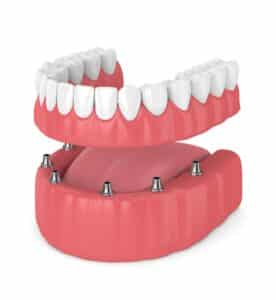
What Is an Implant Overdenture?
An overdenture is a denture that fits over, and his held in place, buy either natural teeth, teeth roots and/or dental implants. These differ from implant bridges or hybrid dentures because they are removable. Dentists sometimes use these devices when they can save some implants or natural teeth to preserve the jawbone supporting and stabilizing the dentures.
Dr. Carl Misch classified two types of overdentures: RP-1 and RP-2. RP-1 overdentures are removable overdentures which are completely supported by implants. RP-2 overdentures are removable overdentures which are partially supported by implants/teeth and partially supported by soft tissue or gums. Here are three of the most common overdentures used today:
- Implant-supported bar overdentures require 3-6 implants inserted into the upper and/or lower jawbones. Each arch/jaw has a precisely fabricated bar permanently fastened to the implants. The overdenture then fits precisely over the bar to establish a snug adaptation to the jaw that is secure during rest and function of the mouth. Dentists and patients generally opt for this type to improve bone strength and keep the existing bone to prevent further weakening or corrosion, as well as, the better fit of a removable prosthesis. This is an example of an RP-1 overdenture.
- Implant-supported partial overdenture suite some patients who need a partial denture because they miss only a few teeth. Patients can remove these prosthetics, but they might not always be comfortable to wear because they can push against adjacent teeth and gums. This is an example of an RP-2 overdenture.
- Implant-supported ball overdentures contain ball-shaped struts or braces that connect the dentures to the implants. Compared to traditional dentures, this construction provides more functionality and stability. However, compared to the bar overdenture, they move more easily and require added maintenance. This is another example of the RP-2 overdenture.
The difference between regular dentures vs. overdentures can seem minimal regarding appearance and function. Like traditional dentures, the purpose of overdentures is to replace some or all of your teeth. Otherwise, most overdentures have added retention gained by remaining teeth or dental implants, therefore, cannot easily become loose like regular ones. Also, they tend to cost more, but they are more effective than conventional dentures at preventing bone deterioration and providing more comfortable chewing.
Implant Overdenture Procedure
As with any dental surgery, the first step to any overdenture implant procedure is to consult your dentist to determine whether you are a good candidate. Your dentist will carry out a thorough examination and ask about your dental and medical history. They will also take photographs and impressions to fit your teeth and bones properly. These images will also reveal the need for bone grafting or other supplemental surgeries. When talking with your dentist, discuss your budget and ask questions.
During implant placement, you will receive a local anesthetic. Additionally, you may desire oral or I. V. sedation for added comfort. After you are numb, the dentist screws the implants into the jaw bone, sometimes using 3-D imaging to know precisely where to place the implants. The surgery concludes with stitches to close the incisions.
Post-procedure care is essential for osseointegration, during which the bone grows around the implants to secure them. This healing process usually requires 3-6 months. After recovery, you will return to the dentist, who will verify the implants are stable and prepare them for impressions.
Now the dentist will take digital scans or make traditional impressions of your teeth and dental implants to send to a lab. Then, a lab technician will take your impressions and create your overdenture.
Once the overdenture comes back from the lab, the dentist will fit it in, making any necessary adjustments. A good fit means that the overdentures are stable and do not hurt when inserting, removing or using the prosthesis. The dentist will also provide instructions on cleaning and caring for your new prosthetic.
How Much Does an Overdenture Cost?
The cost of implant overdentures typically varies by procedure, the number of implants needed, and the specialist who places them. In general, they are more expensive than traditional dentures. Each implant can cost $2,000-$5,000, and patients can expect to pay $25,000 and up for one overdenture arch. The need for additional bone grafting must also be considered when factoring costs.
Pros and Cons of Overdentures
Patients choosing implant overdentures can enjoy their numerous benefits. For example, they allow for eating, talking, or sneezing without the possibility that dentures will slip or fall out. Although, still removable they are a wonderful remedy for missing teeth. Stable and secure overdentures can increase the wearer’s confidence and help them retain a more youthful look. More importantly, they help preserve the jawbone from further deterioration.
Despite their benefits, implant overdentures are not for everyone. They can be cost-prohibitive for some patients. Also, the procedure might not be successful if the patient does not have an adequate amount of jawbone to support the necessary implants.
Patients can turn to alternatives like removable dentures when cost and bone issues make implant overdentures unattainable. The traditional versions can provide comfort and give the wearer a more natural appearance. Another option is the partial denture, which restores function and prevents nearby teeth from moving because of tooth gaps or spaces. Finally, patients who want permanent prosthetics can opt for dental implant bridges which are by far the most superior option for permanent replacement of missing teeth. These permanent implant bridges are also referred to as full arch dental implants or implant hybrid dentures. These are considered the ultimate tooth replacement option since they are permanent replacement teeth which are never removed by the patient.
If you are considering implant overdentures, schedule a consultation with your dentist to learn about the different types, benefits, and risks. Your dentist will also recommend the best overdentures based on your budget and dental needs. They will also answer your questions and work with you to develop a treatment plan.
- Dental Implant Pros and Cons - August 26, 2023
- Receding Gums Stages - August 12, 2023
- When Is It Too Late for Gum Grafting? - July 8, 2023


